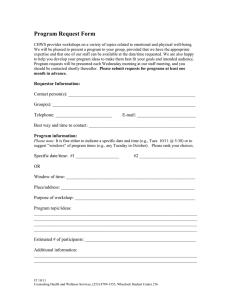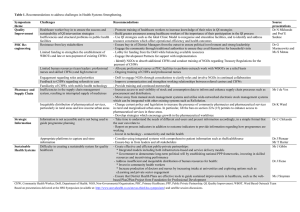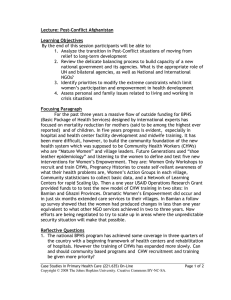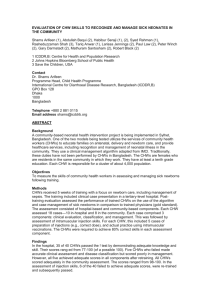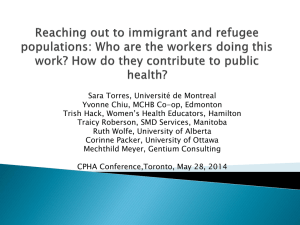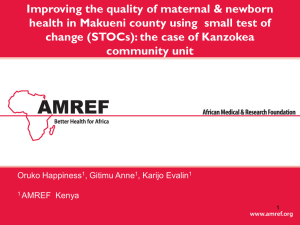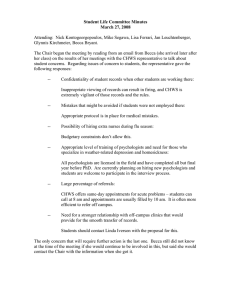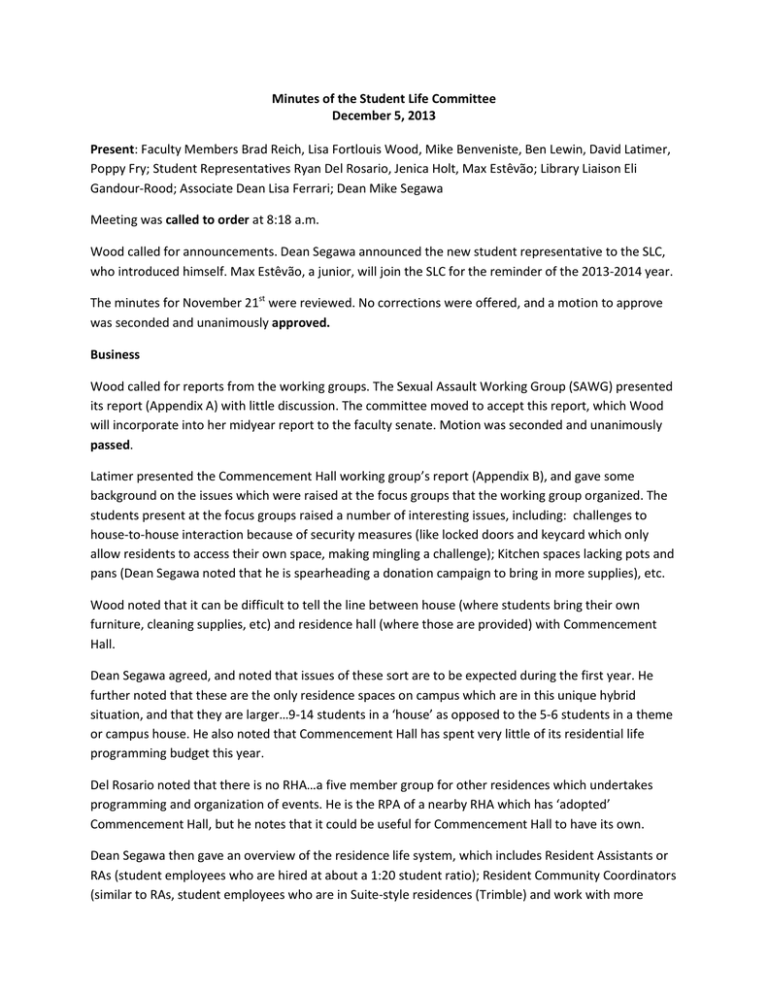
Minutes of the Student Life Committee
December 5, 2013
Present: Faculty Members Brad Reich, Lisa Fortlouis Wood, Mike Benveniste, Ben Lewin, David Latimer,
Poppy Fry; Student Representatives Ryan Del Rosario, Jenica Holt, Max Estêvão; Library Liaison Eli
Gandour-Rood; Associate Dean Lisa Ferrari; Dean Mike Segawa
Meeting was called to order at 8:18 a.m.
Wood called for announcements. Dean Segawa announced the new student representative to the SLC,
who introduced himself. Max Estêvão, a junior, will join the SLC for the reminder of the 2013-2014 year.
The minutes for November 21st were reviewed. No corrections were offered, and a motion to approve
was seconded and unanimously approved.
Business
Wood called for reports from the working groups. The Sexual Assault Working Group (SAWG) presented
its report (Appendix A) with little discussion. The committee moved to accept this report, which Wood
will incorporate into her midyear report to the faculty senate. Motion was seconded and unanimously
passed.
Latimer presented the Commencement Hall working group’s report (Appendix B), and gave some
background on the issues which were raised at the focus groups that the working group organized. The
students present at the focus groups raised a number of interesting issues, including: challenges to
house-to-house interaction because of security measures (like locked doors and keycard which only
allow residents to access their own space, making mingling a challenge); Kitchen spaces lacking pots and
pans (Dean Segawa noted that he is spearheading a donation campaign to bring in more supplies), etc.
Wood noted that it can be difficult to tell the line between house (where students bring their own
furniture, cleaning supplies, etc) and residence hall (where those are provided) with Commencement
Hall.
Dean Segawa agreed, and noted that issues of these sort are to be expected during the first year. He
further noted that these are the only residence spaces on campus which are in this unique hybrid
situation, and that they are larger…9-14 students in a ‘house’ as opposed to the 5-6 students in a theme
or campus house. He also noted that Commencement Hall has spent very little of its residential life
programming budget this year.
Del Rosario noted that there is no RHA…a five member group for other residences which undertakes
programming and organization of events. He is the RPA of a nearby RHA which has ‘adopted’
Commencement Hall, but he notes that it could be useful for Commencement Hall to have its own.
Dean Segawa then gave an overview of the residence life system, which includes Resident Assistants or
RAs (student employees who are hired at about a 1:20 student ratio); Resident Community Coordinators
(similar to RAs, student employees who are in Suite-style residences (Trimble) and work with more
experienced student populations at higher rations and who do less conduct-focused work but more
coordinating of events and have similar training); and Resident Programming Advisors (student
employees who work with RAs in traditional residences to support programming). All are supervised by
one of the three Resident Directors who are full time employees of the university. RDs live on campus,
are often fresh out of graduate programs, and typically stay at UPS for a couple of years.
Wood asked for a motion to accept the report of the Commencement Hall Working Group, and the
motion was seconded and unanimously passed.
The Counseling, Health & Wellness Services (CHWS) working group then discussed its report (Appendix
C). Lewin summarized the report for the group, noting that most of it had already been covered at the
last SLC meeting. He reminded the committee that the CHWS group identified two big issues: the
creation of an ad hoc committee to focus on campus health and wellness issues, and the importance of
data collection. The CHWS working group report includes a number of suggestions from the working
group and from the SLC committee as a whole.
Fry agreed that there are really two pieces of the CHWS report: a focus on the infrastructure for
providing and assessing health and wellness services on campus, and a focus on the messaging or
outreach that the university does for students regarding that infrastructure.
Wood noted the importance of self-advocacy for our students, and how learning to use reasources is an
important part of the college experience. She also wondered how parents are involved, and if the
University is tracking that. Finally, she noted that the University may need to operate more along the
lines of providing guidance and facilitating access, as there is no way we can provide all necessary
resources (though we obviously need to provide rapid response in an emergency, etc), but we can help
educate.
The committee further discussed the role of the University in providing services as opposed to providing
support for students to access services whether on campus or elsewhere, and the importance of clear
messaging, and perhaps the need for an individual to act as a facilitator or advisor or advocate to help
students navigate the system. Regarding the latter suggestion, there was discussion of overlap with the
findings of the SAWG group regarding a sexual assault prevention coordinator…also perhaps part of
wellness efforts. There was also discussion of the fact that the committee (both the full SLC and the
smaller working group) has mostly discussed health and wellness through the lens of either mental
health services or emergency response services, and it was noted that there is also a need to help
students deal with minor but still important issues like sinus infections, etc…which, it was noted,
comprise the majority of visits that CHWS receives.
Dean Segawa suggested that it would be important for the University to clarify what are the levels of
service that we can and cannot provide, and also identify best practices to communicate those levels of
service to our students. He noted that work on this is important, but also will most likely largely need to
take place during summer, when such large projects can be tackled.
Del Rosario then shared personal experiences that he had solicited from other students regarding their
experience with CHWS, including some less-than-positive experiences. Notably, two stories including
one student who had symptoms of mono and was apparently told by CHWS that they tested negative,
so slogged through the rest of the semester, but then much later received a follow up asking how they
were doing with their mono diagnosis…implying that they had in fact tested positive, but that the
diagnosis had been miscommunicated. All of the stories implied communication problems.
The committee noted the challenges of communication, and of students knowing how to navigate the
system, and that these stories underscored the idea of needing an institutional and/or robust group to
evaluate the effectiveness of CHWS…and that the group must have a mandate.
Wood suggested that the SLC return to faculty senate, then , to ask for a more specific charge for the
implementation of a more robust group.
Wood then asked for a motion to accept the CHWS working group’s report, which was seconded and
unanimously passed.
As the meeting was close to its ending time, Wood thanked everyone for their hard work, and thanked
Dean Segawa for providing food and beverages for this final meeting. She noted that when the SLC
reconvenes in the spring, the first order of business will be to establish our plans and priorities for the
spring semester, and to decide how to continue…specifically, whether to continue with our working
group model.
Dean Segawa asked everyone to respond promptly to Paula when she sent out possible meeting times
for Spring, the current possibilities being MWF 8-9am, 12-1pm, or Friday 3:30-5pm.
The meeting adjourned at 9:15 am.
APPENDIX A – SAWG Working Group Report
SLC working group - 11/7
Recommendations of SLC SAWG Working group
1. We recommend that the new sexual harassment policy not be implemented at this time for two
primary reasons. First, it is unclear what the policy’s specific objectives are and, because of
this, prioritization of actions to support the policy is difficult, if not impossible. We suggest a
succinct statement: “The purpose of this policy is _____________” and that everything then
following this statement carries out that specific purpose. Second, we are unclear what the role
of this policy is relative to the current University of Puget Sound Campus Policy Prohibiting
Harassment & Sexual Misconduct. There is duplication and overlap between the two and we
do not know if this is intentional or not. If it is, we need more information as to how the two
will work together.
2. Reconvene SAWG and provide ongoing institutional support to ensure permanence.
3. Identify (through “Permanent SAWG”) the specific purpose of the proposed Sexual Assault
Policy (including whether the policy is sexual assault specific).
4. The University must think about and address SAWG composition (including standing
members and/or staggered membership).
5. The University must think about the time commitment of SAWG members (probable full year
commitment, including summer).
6. Once Permanent SAWG has been created and the Sexual Assault Policy has been revised to
carry out a specified purpose, immediate attention should be given to develop access to the
policy/system, publicizing the policy and how to use it, and training for various groups.
7. Develop assessment criteria for SAWG (data collection, specifically looking at reporting and
effectiveness of resources for reporting). This should run commensurate with the
establishment of access. In other words, it should run from day one.
8. Establish a pattern for regular assessment and review of standing SAWG policy, possibly by a
group separate from SAWG standing membership.
SAWG training recommendations:
- Identify who are mandatory reporters and how they report.
- Determine training program with specific focus and goals (who trains, with what objectives,
and under what order/time frame).
- There are several groups for whom training appears to be recommended. We list them not to
provide an “order”, but to draw attention to the possibility that some groups may be combined,
others may be sequential, and others may follow a different schedule.
1. staff and faculty
2. residence life student staff
3. athletic trainers and coaches
4. greek life
5. orientation leaders
6. campus security
7. Overall student body
8. Potentially partner with Sexual Assault Center of Pierce County
*We suggest that if there is training or information for all students that it should be done early in
the year, and not during orientation week, due to the mass amounts of information given during
this week.
**The current and future role of the green dot program needs to be considered. It is possible it
may be supplementary or redundant.
***The current and future role of BHERT needs to be considered because it goes beyond sexual
assault, if it in fact encompasses sexual assault.
APPENDIX B- Commencement Hall Working Group Focus Groups Report
(See Attached Document)
APPENDIX C- CHWS Working Group Report
Recommendations of CHWS Working Group
Charge: Evaluate the efficacy of Counseling, Health, and Wellness Services, including ways by
which the university promotes good health practices. Issues to consider are a) the impact
on access due to the co-pay fee, b) the provision of university sponsored health insurance, and
c) the adequacy of staffing for mental health services.
The working group that was assigned to evaluate the efficacy of CHWS believes that we do
not have enough data to properly complete this charge. After consultation with the full
Student Life Committee, it was decided that instead of collecting and analyzing new data,
the working group would instead make recommendations as to how this charge may be
effectively completed in the future.
1) We recommend that the faculty senate create an ad hoc committee that is responsible
for an external, independent review of the efficacy of CHWS. A proper evaluation of the
utilization of services and outcomes will require significant time and resources. The
creation of an ad hoc committee would allow for suitable execution of this charge.
2) In order to proper evaluate the efficacy of CHWS data should be collected from a number
of sources. Triangulation is highly recommended; both qualitative and quantitative data
will help evaluators to understand student experiences during CHWS encounters and the
outcomes of these encounters. We recommend survey data and focus group interviews
with students.
3) While the CHWS annual report does contain some useful information, we believe that
there are a number of variables that need to be considered when evaluating CHWS efficacy
that are currently missing. For example, the 2011-2012 annual report discusses student
satisfaction, but does so using questions designed to measure student learning outcomes.
While this may be valuable in some other context, it is not a valid measure of patient
satisfaction. The importance of patient satisfaction is well documented in healthcare
literature. Patient satisfaction correlates with improved physician-patient communication,
continuity of care, and compliance with treatment directives. Although anecdotal, informal
conversations with students reveal that satisfaction with CHWS may be subpar. We
suggest that a more valid measurement be used for assessing satisfaction. We also believe
that it is important to analyze return rates. It is important to understand whether students
who return to CHWS are visiting for new problems or if they are returning because their
original problem was not resolved after the first visit. It is also important to know what
happened to students who did not return after their initial visit. Did the visit successfully
resolve the problem, or did the student go see an off-campus provider to continue
treatment? These are just a few examples of questions that may be addressed with a
thorough assessment carried out by ad hoc committee.
4) Regarding the specific sub points in this charge:
a) consider the impact on access due to the co-pay fee
There was a 23% decline in mental health utilization and a 17% decline in
medical utilization during the 2012-2013 academic year. However, it is impossible to tease
apart the possible causes of the decline in CHWS utilization. The CHWS report states that,
“lower service numbers though the fall were attributed to those new fees.” However, we
are unclear as to how that attribution was made. The report goes on to say that “…
requests for medical services were down in the fall, but seem to have recovered by the
spring semester.” This is ambiguous. Overall, we believe that there is no way to determine
if the changes in utilization are due to staffing, the co-pay, subpar reputation
among students, a healthier population, normal variation in larger trend, etc. More detailed
data is required to properly understand he effect of copay on access to CHWS services.
b) consider the provision of university sponsored health insurance
This is a massive undertaking. A proper consideration of university sponsored health
insurance would require different data than what would be required to evaluate the
efficacy of CHWS. On top of current access, utilization, and outcome data, the committee
working on this part of the charge would need a significant amount of information on
financing, insurance options, etc. While we certainly agree that this worth exploring, it is
beyond the scope of this working group.
c) consider the adequacy of staffing for mental health services.
Given that, as of now, the only data we have to work with is the CHWS annual report, we
can only echo the claims made in that document: CHWS is performing well with the limited
resources that it has, but it is severely understaffed and needs more resources.
5) As noted above, a proper evaluation of CHWS will take a significant amount of time and
resources. While the evaluation is underway, there are some positive steps that CHWS
could take to maintain a healthy relationship with students and continue to deliver
effective care to the campus community. Some recommendations include:
a) Highlighting the use of off-campus resources
b) Creating a “help line” that can be used for either basic health questions or to obtain
information about off-campus health services
c) Finding ways to more effectively utilize the CHWS webpage
d) Q&A sessions with students about CHWS services or general health issues
e) A monthly CHWS email bulletin sent to all students
f) Findings ways to integrate suggestions from the SLC report on sexual assault into
communications between CHWS and students

